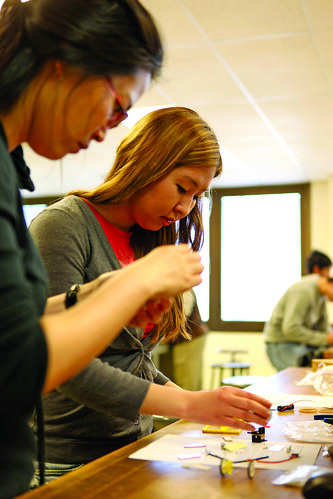A series of events highlighted the environmental efforts of civil engineering students.
Engineering students are quickly becoming some of the most productive components of sustainability efforts at Temple. A series of demonstrations and seminars throughout National Engineers Week provided a look into everything they’ve been working on.
Dr. Naji Khoury, an assistant professor in the engineering department, made international news when his design, which uses plastic bottles for pervious pavement, was included in an article in the Economist last December.
Khoury received a grant from the National Science Foundation to fund his design. With the help of students, the sustainable porous material he developed is used to better manage flooding and overflow in cities, while at the same time making use of plastic waste and replenishing groundwater.

“Without the students, this project would not have made it this far,” Khoury said.
Khoury has been at Temple since August 2008 and has been testing and preparing materials for his design with Jabber Al-Bihani, Chibuikem Okoro and other engineering students from Temple and Carver High School of Science and Engineering.
Khoury’s patent-pending design is made by mixing melted plastic bottles with soil and various other materials, compressing them into precast slabs and then eventually putting them into city sidewalks and roads.
The first one made was placed outside the College of Engineering and Architecture building for observation and testing. Khoury and his colleagues are currently working together with the Office of Sustainability and Facilities Management to eventually install the porous pavement around Main Campus.
One of these tests is to measure how well the material filters out heavy-metal toxins from rainwater. They are in the beginning stages of developing a similar type of material, which will hopefully be capable of filtering oil as well.
The design is in the process of being adopted by Abington Township, and Khoury said his goal is to have his design implemented throughout Philadelphia.
Doing so would lessen the burden of overflows and flooding, saving the city money in the long run. It would also eliminate waste from the massive amount of plastic bottles that don’t get recycled.
“One of the main concerns for the design was the amount of plastic that we produce and send to landfills every year,” Khoury said. “In the U.S. every year we generate 30 million tons of plastic and, roughly, we recycle 7 to 8 percent of those bottles.”
Rouzbeh Tehrani and Youness Sharifi, both civil and environmental engineering graduate students, have also made impressive progress with testing they’ve conducted at Temple. They’ve been working directly with the National Oceanic and Atmospheric Administration to experiment with their method of dispersing the oil from the Deepwater Horizon spill in the Gulf of Mexico.
“We’re looking to see if the normal situation of the beach is healthy enough for degradation of the oil and if not, what would be the next step,” Sharifi said.
Once they receive water samples from the Gulf Coast, Tehrani and Sharifi will measure the nutrient concentration while their colleagues measure dissolved oxygen in the field. They can then determine whether there is an optimum situation for microbial activity based on the results. Oil is the microbes’ food, so if there is a high amount of microbial life, the oil will be degraded at a much faster rate.
Their tests have concluded that by injecting the necessary amount of oxygen and other minerals that would increase oxygen in the water, they can actually force the microbes to multiply in order to better break down the oil.
Sharifi explained similar studies were conducted after the Exxon Valdez oil spill, but at that time, they added fertilizers to the surface water.
“It was successful up to some point but it wasn’t working,” Sharifi said. “They stopped it, and we learned last year, it was because they didn’t have enough oxygen. What I am looking at is not just the microbial community but what the environmental limiting factors are which restrict oil degradation.”
Another event that was held Wednesday allowed engineering students to contend in a timed competition, to be the first to construct miniature solar-powered cars and then race them. Students had an hour and a half to put their models together.
The scoring was based on the creativity in the design of the car, race time, car functionality and whether the car could successfully launch a ping-pong ball.
David Bui, a sophomore electrical engineering major, won the competition.
Brittany Thomas can be reached at brittany.thomas@temple.edu.



Be the first to comment